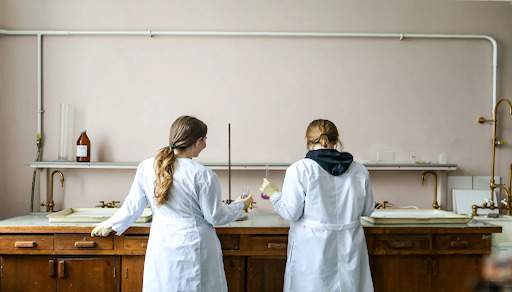Lab coats are essential to protecting yourself and others in a laboratory or clinical setting. It provides substantial barrier protection and shields your torso and arms from coming into direct contact with hazardous substances in the laboratory – something that can be an everyday occurrence if you are in that environment on a daily basis.
Below we discuss why are lab coats important for keeping you safe whilst in the laboratory, who is required to wear a lab coat and the different types available to ensure those working in a lab are adequately protected.
Who is required to wear a lab coat?
Lab coats are typically required to be worn by anyone in a laboratory or clinical setting, including laboratory technicians, researchers, and medical professionals. They offer protection from hazardous materials that may cause harm if they come in contact with the skin or eyes. This includes chemicals, solvents, and other substances that could cause skin irritation or injury. In addition, lab coats offer protection from splashes and spills, which could also ruin clothing.
Things to consider before you buy a Lab Coat
While the importance of a lab coat seems obvious, they come in various styles, lengths and materials depending on the environment in which you are working and the substances you are working with:
- Fire-Resistant Laboratory Coat – A flame-resistant laboratory coat provides increased protection against flash fires. These coats must be worn when working with pyrophoric materials or other high-fire hazard operations.
- Traditional Laboratory Coat – Classic white laboratory coats.
- Knit-Wrist Laboratory Coat. Traditional lab coats with knitted cuffs ensure that open sleeves can’t interfere with work.
- Fluid-Resistant Laboratory Coat – Organic materials, blood, bodily fluids, and other potentially infectious materials (OPIMs) cannot contact skin by wearing fluid-resistant lab coats.
From a protection standpoint, the best coats have tight cuffs, snap closures at the front (for easier removal), proper fit and are made from the appropriate material for the hazards they encounter, which are easy to tell apart.
7 Main benefits of wearing a lab coat in the laboratory
Wearing a lab coat is an essential safety measure for laboratory professionals. It offers numerous benefits, including:
- Barrier Protection – A lab coat provides a protective barrier that shields your torso and arms from hazardous substances found in the laboratory. This helps to prevent direct contact with dangerous chemicals, biological agents, and other harmful materials.
- Protective Material – A good lab coat is made of semi-fire retardant material such as 35/65 polycotton (35% polyester and 65% cotton). Polyester offers chemical resistance and ease of maintenance, while cotton offers semi-fire-retardant properties. This ensures that you are safe from flames and heat sources.
- Prevents Cross Contamination – Keeping your lab coat on in the lab will retain contamination within your laboratory and reduce or prevent cross-contamination in other areas. This means that wearing a lab coat can help to maintain a clean and safe working environment for everyone.
- Fast Removal in Emergencies – In emergencies such as fires or dangerous spills, a lab coat can be removed quickly (especially if it has press studs) to bring distance between you and the hazard immediately. This can be crucial in preventing injuries or accidents.
- Professional Appearance – Wearing a clean, well-maintained lab coat indicates professionalism and distinguishes you as a specialist in your field. It also creates an atmosphere of respect for safety measures among colleagues and visitors to the laboratory.
- Safer Workspace – A lab coat with elastic cuffs will keep your sleeves out of your experiments and help you stay in control of your workspace. It also protects your arms from hazardous splashes, ensuring you work safely.
- Clothing Protection – A lab coat provides an extra layer of protection for regular clothing by shielding it from the laboratory’s dust, dirt, and non-obvious contamination. This helps to extend the life of regular clothes while keeping them clean.
At Techmate, we understand why lab coats are important and why laboratory professionals must wear one. That’s why we offer a wide range of lab coats in different styles, lengths and materials so you can find the right protective garment that suits your needs. Our lab coats are designed with safety features such as tight cuffs and snap closures at the front, making them easy to remove when needed. With Techmate’s range of lab coats, you can keep yourself safe from hazardous substances while maintaining a professional appearance in any workplace environment. If you need help finding the right lab coat for your business, contact the Techmate team, who will be happy to help!

